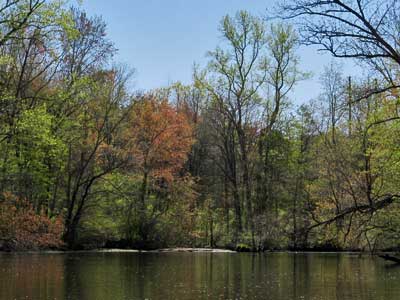
Tuckahoe Creek is one of the most beautiful and diverse creeks in Maryland. Access to the creek is available below Crouse Dam (near Tuckahoe State Park), from Hillsboro, Md., or from the launching ramp along rt. 328
Below the dam, the creek is freshwater. The creek becomes tidal above Hillsboro, near the abandoned railroad bridge. From Crouse Dam, Tuckahoe Creek flows approximately 21 miles to its confluence with the Choptank River.
Kayaking
Although it is possible to make a one-way trip departing from the Crouse Dam access point and hauling out at Hillsboro, this route can be a difficult trip.
The trip downstream from the dam usually requires a guide or local outfitter for drop off and haul out. At times, sections of the creek’s upper stretches are blocked by trees, requiring paddlers to haul out in rugged terrain in order to go around blockages.
Another way to explore the Tuckahoe is by departing from Hillsboro, paddling upstream, and returning to the same launch area. Traveling upstream from Hillsboro, paddlers will encounter several historic bridges as well as a variety of habitats. The creek is wide and shallow with few obstructions.
Above the route 404 bridge, the creek begins to narrow and make a series of sharp turns. The banks change abruptly from gentle slopes to steep, wooded bluffs. Sandbars occur in several spots along the creek, many of which are exposed during periods of low water. In a few areas, lily pads grow.
Along this stretch of the creek, kayakers are sometimes surprised to see horse riders appear along the bank. A trail on the Caroline County side of the creek provides access for riders.
As the creek narrows further, it becomes almost totally shaded by the tree canopy. Along this stretch, the bottom is very sandy and littered with downed trees. The current is quite fast in spots, especially where logs restrict the creek. Beavers and river otters occupy the woodland stretch of the creek, although they are seldom seen by humans.
The trip back downstream to Hillsboro requires less effort as the current propels kayaks along with very little paddling. The downstream run is a good time to enjoy the scenery, take photographs or just relax.
Fishing
Fishing in the creek varies considerably by season, location, weather, and other factors. On any given day, the creek’s water flow, clarity, temperature, tidal state, and other characteristics can have major impacts on fishing. Although the creek is susceptible to rainfall, much of the creek is sheltered from the wind.
Tuckahoe creek is best known for its spring spawning migrations of yellow perch (ringed perch), white perch, hickory shad, and river herring. Although these fish can be caught throughout the spring season, peak fishing for a given species often occurs only a few days.
Among the first fish to arrive are yellow perch, which begin moving up from the Nanticoke River in late February. Initially, yellow perch stage in deep holes and are sometimes caught in large numbers. As the creek warms, yellow perch move further upstream into shallow runs and quiet pools.
Following soon after are white perch, hickory shad, and river herring.White perch migrate similar to yellow perch, moving into deep pools initially before making their way into the upper creek’s spawning habitat.
Hickory shad and river herring are among the most challenging fish that occur in Tuckahoe creek. Each spring, shad and herring migrate from the Atlantic Ocean into coastal creeks and streams, including the Tuckahoe and other Chesapeake Bay tributaries. They may arrive suddenly and at times can be seen spawning in areas where shallow, stony bottoms occur. Although they rarely take baited lines, they readily accept shad darts and other small lures.
For fly fishermen, Tuckahoe Creek is one of the few areas in Maryland where anglers can find open stretches of creek, hard, stony bottoms, and flowing water. These conditions allow anglers to disembark from a small boat and catch shad or other species with fly fishing tackle.
Tuckahoe Creek is also home to largemouth bass, chain pickerel, channel catfish, brown bullheads, redbreast sunfish, fallfish, and other freshwater species. Each species has a unique set of preferences for habitat, water conditions, and other factors. Because of the tremendous variety of habitats, water conditions and diversity of fish species, fishing the creek can be a challenge.
In addition to traditional fisheries, Tuckahoe Creek contains two of the Mid Atlantic’s most notorious invasive species, northern snakeheads and blue catfish.
Although the creek is not large, its physical characteristics can present limitations. Upstream from Hillsboro, much of the creek is shallow and strewn with fallen trees, rocks, and other debris. These obstacles make the creek’s upper stretches unnavigable except by kayak, canoe, or other small craft.
Below Hillsboro, the creek widens and slows somewhat, although the entire tributary is known for its fast moving water. The lower Tuckahoe is accessible by bass boats and other small to mid-sized pleasure boats. Along the lower Tuckahoe, anglers fish for largemouth bass, chain pickerel, catfish and perch.